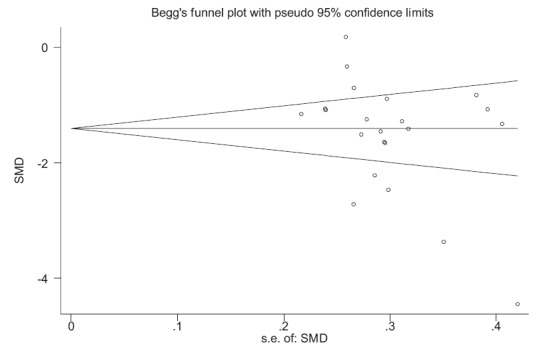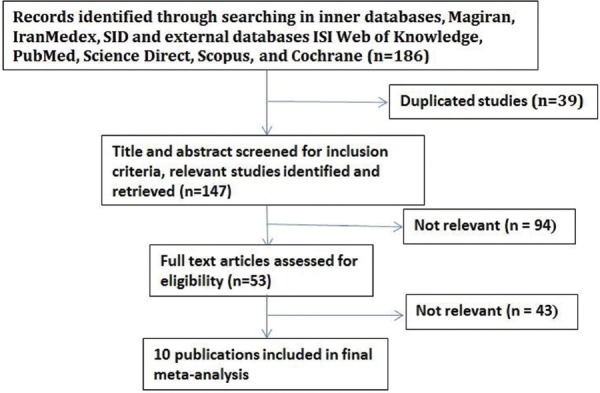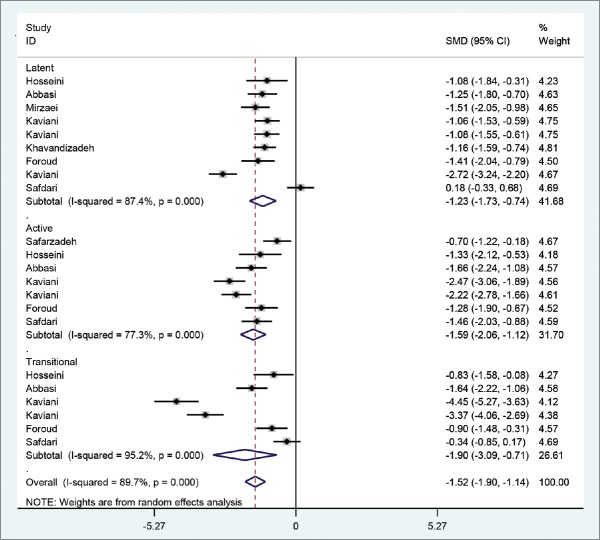Abstract
Background:
Pain is a common experience for women during labor. Therefore, pain relief care for mothers during labor is very important. This meta-analysis was conducted to evaluate the efficacy of massage therapy on labor pain reduction in primiparous women.
Materials and Methods:
In this meta-analysis, the databases of Web of Knowledge, PubMed, Scopus, Cochrane, Iranmedex, Scientific Information Database (SID), and Magiran were searched for published articles in English and Persian language up to January 2016. Among the studies, with regard to the inclusion and exclusion criteria, 10 studies were selected. Data were analyzed by using Stata software version 11, and standard mean difference (SMD) of effects of massage therapy was calculated. The heterogeneity among studies was evaluated by the Chi-square based Q-test and I2 statistics.
Results:
The results of Chi-square based on Q-test and I2 statistics showed heterogeneity among studies in the latent phase (Q = 63.52, P value < 0.001 and I2 = 87.4%), active phase (Q = 26.42, P value < 0.001, and I2 = 77.3%), and transitional phase (Q = 104.84, P value <0.001, and I2 = 95.2%). Results showed that massage therapy reduces labor pain in the latent phase (SMD = −1.23, 95% CI: −1.73 to −0.74), active phase (SMD = −1.59, 95% CI: −2.06 to −1.12), and transitional phase (SMD = −1.90, 95% CI: −3.09 to −0.71).
Conclusions:
This study provides valid evidence for the effect of massage therapy in Iran for labor pain relief. Therefore, the use of massage therapy can be recommended in the primiparous women.
Keywords: Delivery, Iran, labor pain, massage, meta-analysis, obstetric
Introduction
Labor pain intensity is one of the most severe pains that almost all women experience during labor,[1,2] which may have some adverse effects for the mothers and fetus.[3,4] Fear of labor pain, especially in primigravida, women may affect their option for the type of delivery in subsequent labors, and increase mothers' tendency for cesarean.[5,6] The results of a systematic review and meta-analysis showed that the prevalence of cesarean has increased in Iran in recent years; the overall prevalence of cesarean in Iran was estimated to be 48% and fear of normal delivery pain was identified as one of the main causes of cesarean prevalence.[7]
Therefore, pain relief care for mothers during labor is very important, and both pharmacological and nonpharmacological methods can be used for this purpose. The use of complementary and alternative medicine (CAM) for pain reduction among women during labor has grown in the past decade.[1,8,9] In women with respiratory and heart diseases or mothers who have allergy to drugs, use of nonpharmacological methods such as CAM is more necessary as an alternative.[10] Massage, muscle relaxation, breathing techniques, music therapy, mind body techniques, reflexology, herbal medicines, hypnosis, and touch therapy are some types of CAM that use to reduce the pain in the world.[2,11,12] Massage therapy for pain relief during labor stage can reduce need for analgesic drug consumption.[2]
There are some studies in Iran in this regard, however, there is no overall conclusion. Primiparous women because of their first experience may be feeling more pain. Therefore, this meta-analysis was conducted to evaluate the efficacy of massage therapy on labor pain reduction in primiparous women.
Materials and Methods
In this meta-analysis, the databases of Web of Knowledge, PubMed, Scopus, Cochrane, Iranmedex, Scientific Information Database (SID), and Magiran were searched for published articles in English and Persian language up to January 2016. Among the studies with regard to the inclusion and exclusion criteria, 10 studies (out of 186 publications) were selected.
The search was conducted with all possible combinations of key words; Massage and Women and Iran. In English language databases, the search strategy was (“Massage”) AND (“Delivery” OR “labor”) AND (Iran). The review is conducted based on the PRISMA guidelines.[13] Two researchers independently followed quality assessment of articles using the Consolidated Standards of Reporting Trials (CONSORT).[14]
All available randomized controlled clinical trials in English and Persian language were included if: (1) they were carried out in Iran; (2) participants were randomized into a massage or control group; (2) participants were primiparous; (3) the outcome of study was labor pain and was reported separately in three phases of delivery including; latent, active, and transitional.
Studies were excluded if the experimental group received multiple treatments or the control group undertook any practice that could be perceived to relief pain, studies with duplicate citation, and also studies with failure to report the necessary data for meta-analysis (mean and standard deviation).
Data were analyzed by using Stata software version 11 (StataCorp LP, 4905 Lakeway Drive, College Station, TX 77845, USA), and Standard Mean Difference (SMD) of effects of massage therapy was calculated. The heterogeneity among studies was evaluated by the Chi-square based on Q-test and I2 statistics with a significance level of <0.1. Based on the rejection of homogeneity hypothesis, random effect models were applied for the estimation of pooled effect. Test for overall effect (Z-score) was regarded significant at P < 0.05. Potential publication bias among studies was assessed by Funnel plot.
Ethical considerations
The research proposal was approved by the Ethics Council of Arak University of Medical Sciences with ethics number IR.ARAKMU.REC.1395.34. Because this is a review study, informed consent was not required.
Results
The first step of search in the mentioned databases yielded 186 publications. Removing the duplicate studies and considering the inclusion and exclusion criteria, 10 studies[10,15,16,17,18,19,20,21,22] were selected for the meta-analysis [Figure 1 and Table 1]. The total number of samples in the selected 10 studies was 702 people.
Figure 1.
Flow diagram showing the different phases involved in searching for relevant publications
Table 1.
The characteristic of studies were included in the meta-analysis

There was heterogeneity among studies based on the results of the Chi-square test based on Q-test and I2 statistics showed in the latent (Q = 63.52, P value <0.001, and I2 = 87.40%), active phase (Q = 26.42, P value <0.001, and I2 = 77.30%), and transitional phase (Q = 104.84, P value <0.001, and I2 = 95.20%). Therefore, the random effect model was used in the meta-analysis.
The forest plot of eligible articles for estimating the effect of massage therapy on labor pain in latent, active and transitional phase of delivery in Iran is presented in figure 2. In these plots; SMD, 95% confidence interval (95% CI) and the weight assigned to each study are reported. Results showed that massage therapy reduces labor pain in overall (SMD = −1.52, 95% CI: −1.90 to −1.14) and also in the latent phase (SMD = −1.23, 95% CI: −1.73 to −0.74), active phase (SMD = −1.59, 95% CI: −2.06 to −1.12), and transitional phase (SMD = −1.90, 95% CI: −3.09 to −0.71) [Figure 2].
Figure 2.
Forest plot of effect of massage therapy on labor pain in latent, active and transitional phase of delivery, The size of each square represents the weight of each study and the lines around it percent 95% CI
There was not enough evidence for asymmetry among included studies in funnel plot [Figure 3].
Figure 3.

Funnel plot of studies included in the meta-analysis
Discussion
This study summarized the findings of randomized clinical trials regarding massage therapy of labor pain in Iran, and showed that massage therapy reduces labor pain in overall as well as separately in the latent, active, and transitional phase of labor. Recently, Ganji et al. conducted a systematic review based on articles published between 1990 and 2015 in the world and recommended massage therapy for pain relief in child birth.[23] In the systematic review by Huntley et al. in 2003, there was sufficient evidence only for efficacy of intracutaneous sterile water injections, however, they did not find enough evidence for any other CAM for pain relief during labor.[24] Tournaire et al. in a review in 2006 regarding CAM for pain reduction in labor found an efficacy only for acupressure and sterile water blocks, acupuncture, and hydrotherapy.[25]
Simkin et al. conducted a review regarding the effect of massage as well as 4 other nonpharmacologic methods for pain relief. They concluded that all of the 5 methods are effective and safe for pain reduction in labor.[26]
The differences between all these studies with the present study is that they did not have any statistical analysis for the estimation of the overall effect size, and also included related study from around the world, unlike the present study that is limited to Iran. Effect of massage may vary because of different experiences of caregivers and cultural conditions of each country; therefore, it is better to survey the overall effect locally in each country.
The strengths of the present study are that it summarized the evidence quantitatively and was conducted specifically only for pain outcome. However, it has some limitations such as combining the results of studies with different methods for message and different massage duration; however, the heterogeneity between studies was controlled by using random effect model for meta-analysis.
The main strength of this study was high statistical power due to high sample size resulting from the integration of different studies. Furthermore, the main limitation was that pooled estimated of effect measure from studies with different massage skills or the different time taken for massage may not be without criticism.
Conclusion
Based on the results of clinical randomized control trials in Iran, this study provides valid evidence for effect of massage therapy in Iran in labor pain relief. Therefore, the use of massage therapy can be recommended in the primiparous women.
Financial support and sponsorship
Arak University of Medical Sciences.
Conflicts of interest
There are no conflicts of interest.
Acknowledgments
The authors gratefully acknowledge the Research Council of Arak University of Medical Sciences (Grant Number: 2561) for the financial support.
References
- 1.Dehcheshmeh FS, Rafiei H. Complementary and alternative therapies to relieve labor pain: A comparative study between music therapy and Hoku point ice massage. Complement Ther Clin Pract. 2015;21:229–32. doi: 10.1016/j.ctcp.2015.09.002. [DOI] [PubMed] [Google Scholar]
- 2.Hajiamini Z, Masoud SN, Ebadi A, Mahboubh A, Matin AA. Comparing the effects of ice massage and acupressure on labor pain reduction. Complement Ther Clin Pract. 2012;18:169–72. doi: 10.1016/j.ctcp.2012.05.003. [DOI] [PubMed] [Google Scholar]
- 3.Brownridge P. The nature and consequences of childbirth pain. Eur J Obstet Gynecol Reprod Biol. 1995;59:S9–15. doi: 10.1016/0028-2243(95)02058-z. [DOI] [PubMed] [Google Scholar]
- 4.Labrague LJ, Rosales RA, Rosales GL, Fiel GB. Effects of soothing music on labor pain among Filipino mothers. Clin Nurs Stud. 2013;1:p35. [Google Scholar]
- 5.Beigi NMA, Broumandfar K, Bahadoran P, Abedi HA. Women's experience of pain during childbirth. Iran J Nurs Midwifery Res. 2010;15:77. [PMC free article] [PubMed] [Google Scholar]
- 6.Khorsandi M, Ghofranipour F, Heydarnia A, FaghihZadeh S, Vafaei M, Rousta F, et al. The effect of childbirth preparation classes on childbirth fear and normal delivery among primiparous women. Arak Med Univ J. 2008;11:29–36. [Google Scholar]
- 7.Azami-Aghdash S, Ghojazadeh M, Dehdilani N, Mohammadi M, Abad RAA. Prevalence and Causes of Cesarean Section in Iran: Systematic Review and Meta-Analysis. Iran J Pub Health. 2014;43:545–55. [PMC free article] [PubMed] [Google Scholar]
- 8.Khadivzadeh T, Ghabel M. Complementary and alternative medicine use in pregnancy in Mashhad, Iran, 2007-8. Iran J Nurs Midwifery Res. 2012;17:263. [PMC free article] [PubMed] [Google Scholar]
- 9.Can HO, Saruhan A. Evaluation of the effects of ice massage applied to large intestine 4 (hegu) on postpartum pain during the active phase of labor. Iran J Nurs Midwifery Res. 2015;20:129. [PMC free article] [PubMed] [Google Scholar]
- 10.Kaviani M, Gholami Z, Azima S, Abbasnia K, Rajaifard A. The Comparison of Superficial and Vibration Massages on Backache during Labor in Primiparous Women. Iran J Obstet Gynecol Infertil. 2011;14:45–50. [Google Scholar]
- 11.Abbaspoor Z, Akbari M, Najar S. Effect of Foot and Hand Massage In Post–Cesarean Section Pain Control: A Randomized Control Trial. Pain Manag Nurs. 2014;15:132–6. doi: 10.1016/j.pmn.2012.07.008. [DOI] [PubMed] [Google Scholar]
- 12.Matourypour P, Vanaki Z, Zare Z, Mehrzad V, Dehghan M, Ranjbaran M. Investigating the effect of therapeutic touch on the intensity of acute chemotherapy-induced vomiting in breast cancer women under chemotherapy. Iran J Nurs Midwifery Res. 2016;21:255. doi: 10.4103/1735-9066.180373. [DOI] [PMC free article] [PubMed] [Google Scholar]
- 13.Moher D, Liberati A, Tetzlaff J, Altman DG. Preferred reporting items for systematic reviews and meta-analyses: The PRISMA statement. Ann Intern Med. 2009;151:264–9. doi: 10.7326/0003-4819-151-4-200908180-00135. [DOI] [PubMed] [Google Scholar]
- 14.Schulz KF, Altman DG, Moher D. CONSORT 2010 statement: Updated guidelines for reporting parallel group randomised trials. BMC Med. 2010;8:1. doi: 10.4103/0976-500X.72352. [DOI] [PMC free article] [PubMed] [Google Scholar]
- 15.Safarzadeh AM, Khodakarami N, Fathizadeh N, Safdari Dehcheshmeh F. The effect of massage therapy on the severity of labor in primiparous women. J Shahrekord Univ Med Sci. 2008;9:20–5. [Google Scholar]
- 16.Hosseini S, Asadi N, Zareei F. Investigating the effect of massage therapy on labor in the active stage of first labor. Iran J Nurs Res. 2014;9:25–32. [Google Scholar]
- 17.Abasi Z, Abedian Z, Fadaie A, Esmaeili HA. The Effects of Back Massage on Pain Intensity during the First Stage of Labor in Primiparous Women. Iran J Obstet Gynecol Infertil. 2008;11:39–47. [Google Scholar]
- 18.Mirzaei F, Kaviani M, Jafari P. Effect of Foot Reflexology on Duration of Labor and Severity of First-Stage Labor Pain. Iran J Obstet Gynecol Infertil. 2010;13:27–32. [Google Scholar]
- 19.Khavandizadeh Aghdam S, Adib A, Kazemzedeh R. The Effects of Massage during Labor on Pain and Length of Delivery in Nulliparous Women. Iran J Obstet Gynecol Infertil. 2014;16:15–20. [Google Scholar]
- 20.Foroud A, Foroud A, Mehdipour S. The effects of breathing patterns and massage on the pain and perception of labor in primiparous women. J Shahrekord Univ Med Sci. 2006;7:70–7. [Google Scholar]
- 21.Kaviani M, Ashoori M, Azima S, Rajaei Fard A, Hadian Fard M. Comparing the Effect of Two Methods of Acupressure and Ice Massage on the Pain, Anxiety Levels and Labor Length in the Point LI-4. J Shahid Sadoughi Univ Med Sci. 2012;20:220–8. [Google Scholar]
- 22.Safdari Dehcheshmeh F, Delaram M, Salehian T, Moradi MT, Rahimi Madiseh M, Aliakbari F. Relief of labor pain by ice massage of the hand. Zahedan J Res Med Sci. 2009;11:23–9. [Google Scholar]
- 23.Ganji J, Jafari Z, Keramat A. The effectiveness of massage on labor pain and duration of labor: Systematic Review. Iran J Obstet Gynecol Infertil. 2015;18:19–27. [Google Scholar]
- 24.Huntley AL, Coon JT, Ernst E. Complementary and alternative medicine for labor pain: A systematic review. Am J Obstet Gynecol. 2004;191:36–44. doi: 10.1016/j.ajog.2003.12.008. [DOI] [PubMed] [Google Scholar]
- 25.Tournaire M, Theau-Yonneau A. Complementary and alternative approaches to pain relief during labor. Evid Based Complement Altern Med. 2007;4:409–17. doi: 10.1093/ecam/nem012. [DOI] [PMC free article] [PubMed] [Google Scholar]
- 26.Simkin PP, O'Hara M. Nonpharmacologic relief of pain during labor: Systematic reviews of five methods. Am J Obstet Gynecol. 2002;186:S131–S59. doi: 10.1067/mob.2002.122382. [DOI] [PubMed] [Google Scholar]




